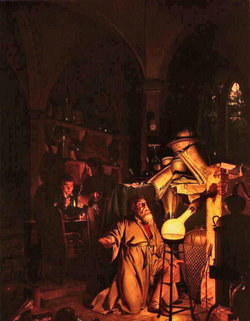 Right: enough of the whippersnapper Kipling. I think you’re ready for some ancient wisdom: how to understand the essence.
Right: enough of the whippersnapper Kipling. I think you’re ready for some ancient wisdom: how to understand the essence. The alchemists had a number of techniques. Perhaps the simplest was to boil off the spirit and distil it. Then take the distillate, boil off the spirit and distil it. Then repeat. And repeat. And repeat. By which time you should have got to something pretty pure. the five times distilled “quintessence”.
Swooping back to the present, Nicholas Bate's series on "Simplicity, the far side of complexity" rolls on. Episode four is "Dig Deep: Find The Real Issue". But how deep? Bate offers "Deeper", with the implication that you'll know when you've gone far enough.
Slithering back a couple of decades, let me offer a tip I got from Shoji Shiba, the TQM guru, in the early 90s. He recommends that, however well you think you understand a question, you will always understand it better if you go down five levels.
This is a trivial example. As often as not, round about the fourth question, you break through a bland, conventional explanation to get down into the root of a problem, or make a lateral link that gives a new and useful insight.1. Why didn't I get the management team to sponsor my project?
A. Because the presentation was poorly prepared
2. Why was the presentation poorly prepared?
A. Because I did it in a rush the day before
3. Why did I do it in a rush the day before?
A. Because I was too tired to make time amongst all my other priorities until I had no option
4. Why was I so tired?
A. Because I stay up late browsing social media late into the night
5. Why do I stay up late browsing social media?
A. Because I don't feel I've achieved anything worthwhile during the day
This is very much Mother Nature's learning strategy, as any parent of a small child will recognise. Can a million years of evolution be wrong?
Perhaps it should be "The Rule of Five Year Olds"?
Try it: it costs nothing to release your inner toddler!
5 More 5s
- Pentagrams: getting ready to celebrate the feast of All Souls?
- The Five Marks of Mission: the CofE has always been corporate. Whilst I wouldn’t normally recommend a five part mission statement, theirs is worth five minutes’ contemplation. Would Jesus have allowed weasel words like “seek to” and “strive to”? Still, a good effort, I think. Having read it, how does yours stack up?
- Five honest serving men: Any of the five Ws from Kipling’s six will each guide you faithfully down to the next level of insight. I had forgotten that he rested them during working hours. Times have changed.
- Five steps to a project: David Allen’s Natural Planning Model will bring focus and purpose to any task. Requires: the back of an envelope, a pencil and five minutes.
- Quintessence